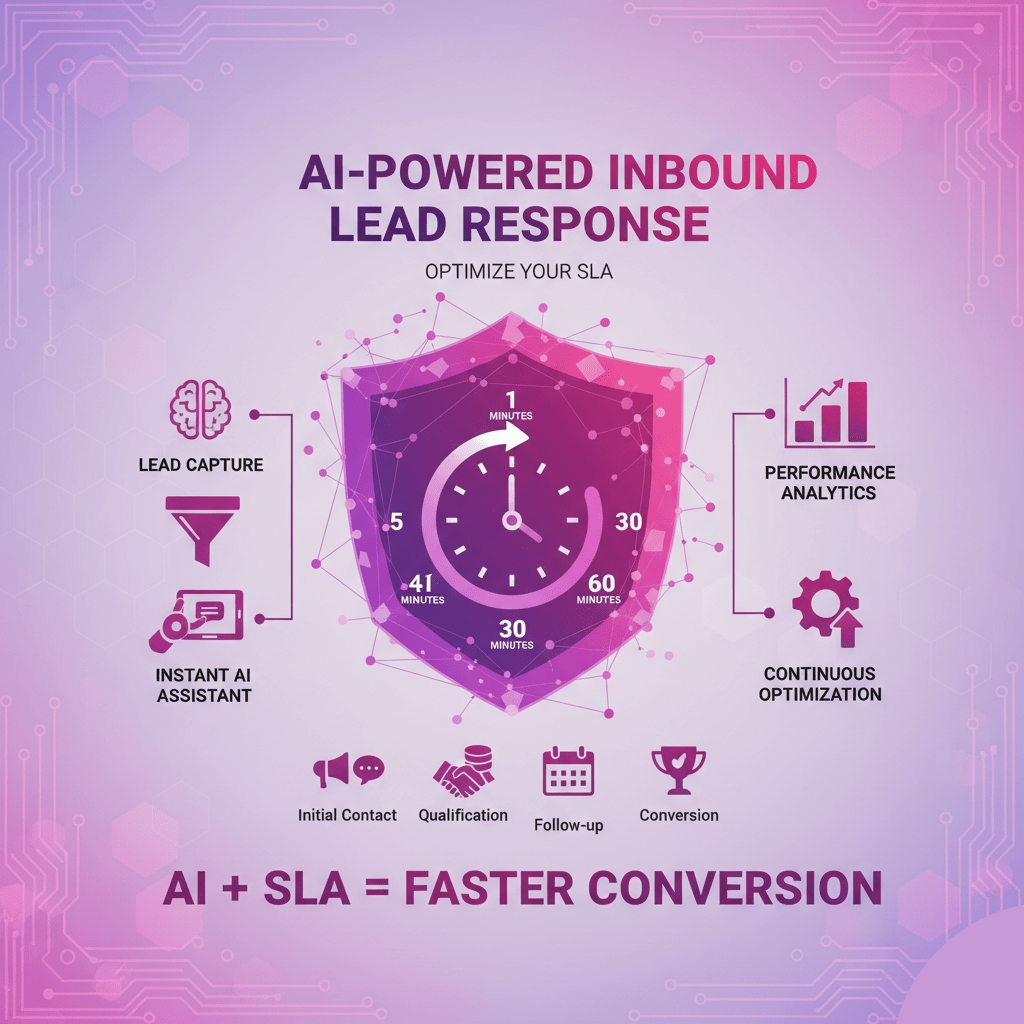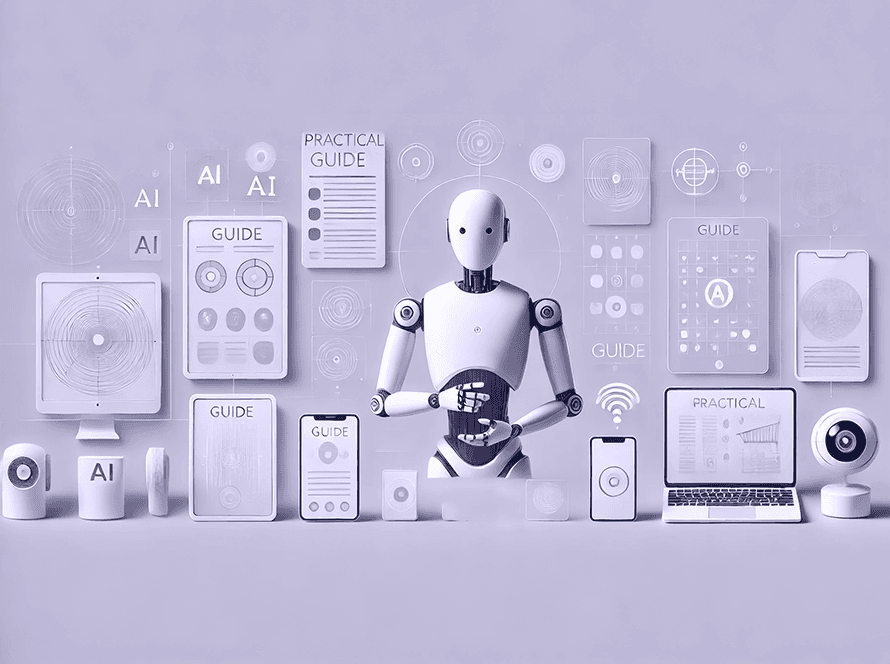“Ensure a sub-60-second response, 24/7, for every lead with an AI-powered inbound lead response SLA, maximizing marketing ROI and booking qualified demos instantly.”
Let’s play out a scenario.
It’s 9:15 PM on a Tuesday. A prospect, a VP of Operations at a 500-person company, is finally catching up on work after putting her kids to bed. She has been researching a solution to a major logistics problem. She lands on your website, reads a case study, and, impressed, fills out your “Request a Demo” form.
This is it. The perfect, high-intent, ideal customer profile (ICP) lead. Your marketing team just spent $150 on the ad clicks that got her there.
What happens next?
Suppose you’re like 90% of B2B companies, whose leads are in a CRM queue. It gets assigned to a sales rep—let’s call him Bob. Bob is, quite reasonably, asleep.
On Wednesday at 9:05 AM, Bob logs in, sips his coffee, and starts sorting through his inbox. He sees the lead. He conducts some research on her company. Around 9:45 AM, he sends a carefully crafted email: “Hi, I saw you requested a demo. Are you free to chat next week?”
He gets no reply.
Why? Because at 9:20 PM on Tuesday, twelve hours earlier, your competitor—who also received a click—had an automated system that triggered an instant response. By 9:25 PM, she had a confirmed demo time scheduled for Wednesday afternoon. By the time Bob’s email landed, her problem was already on its way to being solved.
Your $150 in ad spend? Gone. The potential $150,000 lifetime value of that client? Also gone.
This isn’t a rare failure. This is the daily, hourly, and minutely reality for businesses that rely on human-only inbound lead management.
The gap between marketing’s success and sales’ response is the single most enormous “leaky bucket” in most companies. The tool designed to fix this is the Service Level Agreement (SLA)—specifically, the marketing and sales SLA for inbound lead response. And the gold standard for that SLA is clear: five minutes.
The problem? For a human team, a 5-minute SLA is not only complex to meet, but it’s also statistically impossible.
This article examines the severe consequences of failing to meet the SLA and introduces the only proven method to ensure a sub-60-second response, 24/7/365. It’s time to stop managing the SLA and start solving it with AI for inbound lead response SLA.

The Brutal, Unforgiving Math of “Speed to Lead”
In the world of inbound sales, “speed to lead” isn’t just a vanity metric. It is the most critical variable that determines whether you will ever speak to a prospect. The moment a person fills out a form on your website, they are at peak intent. Their problem is top-of-mind. They are currently actively seeking a solution.
This “peak intent” window is terrifyingly short. It’s not a day. It’s not an hour. It’s minutes.
The foundational research in this space, often cited from a study by Lead Response Management, is staggering.
- The odds of contacting a lead drop by 100 times if you wait 30 minutes versus 5 minutes.
- The odds of qualifying that lead (as in, having a meaningful conversation) drop by 21 times in that same 30-minute window.
Let that sink in. Waiting just 30 minutes—a timeframe that most sales teams would consider fast—makes your lead 21 times less likely to become a qualified opportunity.
Modern buyers expect instant gratification. Think about it. We live in an on-demand world. We get instant answers from Google, instant shipping from Amazon, and instant access to entertainment from Netflix. When a professional B2B buyer takes the “action” step of filling out a form, they expect an “instant” reaction.
When they don’t get one, they don’t just sit and wait. They hit the “back” button and click on the following Google result—your competitor.
Data from other industry leaders confirms this.
- A study by Drift found that only 7% of companies respond within five minutes of a lead submission.
- That same study found that 55% of companies took more than five days to respond, or didn’t respond at all.
This is no longer a small leak; it’s a firehose of wasted marketing budget.
Your company spends tens of thousands, or even millions, of dollars a year to generate these precious inbound leads. Every lead that comes in late at night, on a weekend, or during an all-hands meeting represents a direct waste of that marketing spend. If your sales team only responds to 40% of leads within a (slow) 24-hour window, you are literally throwing 60% of your marketing budget into a shredder.
This is the core disconnect. Marketing’s job is to fill the pipeline. Sales’ job is to close the deals. But in between, there’s a black hole where leads go to die. This black hole is the “response gap.”
The 5-minute SLA was established to address this issue. It’s a formal agreement between marketing and sales: “Marketing will deliver high-quality leads, and in return, Sales agrees to action every single one of those leads in under five minutes.”
It’s a beautiful idea. And it’s a complete fantasy.
The Human Bottleneck: Why Your Sales Team is Set Up to Fail
Let’s be clear: when leads are missed, it’s rarely the fault of an individual sales rep. Your team is likely full of smart, hungry, and hardworking people.
The problem isn’t the people. It’s the system.
Relying on a human sales team (SDRs, BDRs, or AEs) to meet service-level agreements of five minutes is a fundamentally flawed process. You are asking them to do the impossible. Here’s why.
1. The 24/7/365 Problem: Leads Don’t Keep Business Hours
Your website is your single best salesperson. It works 24 hours a day, 7 days a week, 365 days a year. It never sleeps, never takes a vacation, and never gets sick.
Your human sales team, on the other hand, does all of those things.
A typical B2B sales rep works about 40-50 hours a week. A week contains 168 hours. This means, at best, your sales team is only available to respond to leads less than 30% of the time.
What happens to the 70% of leads that come in:
- At 8:00 PM on a Wednesday?
- At 11:00 AM on a Saturday?
- At 7:00 AM on a Monday (before your rep has logged on)?
- During the company-wide holiday party?
Every single one of these leads is a guaranteed SLA failure. The 5-minute window closes before your representative even knows the lead exists. By the time they see it the next business day, it is 12, 24, or even 72 hours old. At that point, the lead isn’t just cold; it’s frozen. You’re not doing sales; you’re performing archaeology.
2. The “Busy Rep” Paradox
Now, let’s consider the “best-case” scenario. A perfect lead comes in at 2:00 PM on a Tuesday. Your best rep, Sarah, is assigned the lead. The 5-minute clock starts.
But what is Sarah doing at 2:00 PM?
- She’s in the middle of a critical demo with another high-value prospect.
- She’s on a closing call with a deal set to sign this quarter.
- She’s in a 1-on-1 with her manager.
- She’s at lunch.
- She’s in the bathroom.
- She’s intensely focused on writing a complex proposal.
You hired Sarah to be a high-performance closer, yet the 5-minute SLA demands she operate like a 911 dispatcher—dropping everything the second a notification pops up.
This context-switching is brutal. It kills productivity and morale. Reps are forced to choose between servicing the customer they have (in a demo) and chasing the lead they might get. It’s a no-win situation.
3. The Failure of Lead Routing Systems (Round Robins)
To address the “busy rep” issue, many companies employ an automated lead routing system, such as a round-robin approach. The lead comes in, and the CRM automatically assigns it to the next available representative.
This seems fair, but it’s not fast.
Let’s trace the journey of a lead in a typical round-robin system:
- 0:00: Lead submits form.
- 0:30: CRM processes the lead.
- 0:45: Lead is assigned to Rep A. A notification is sent (email, Slack, etc.).
- 1:00: Rep A is busy on a call and doesn’t see the notification.
- 5:00: The SLA is officially breached. The lead is still waiting.
- 10:00: Rep A’s “re-notification” timer goes off. He’s still busy.
- 15:00: The system’s “timeout” rule kicks in and re-assigns the lead.
- 15:15: Lead is assigned to Rep B. A notification is sent.
- 16:00: Rep B is grabbing a coffee and misses the notification.
- 20:00: Rep B returns to his desk, sees the notification, and opens the lead record.
- 22:00: Rep B finally makes the first call.
The lead, who had 10 minutes of free time, is now in their next meeting. They ignore the call from an unknown number. The rep leaves a voicemail. And that lead is, for all practical purposes, dead.
The round-robin system is designed for the fairness of distribution, not the speed of response.
4. The Nightmare of Sales Operations Management
If you’re a sales or marketing leader, how do you even enforce the SLA? How do you accurately track lead response time?
Most CRMs are terrible at this. They can tell you when a lead was created and when it was assigned to you. However, tracking the actual time to first meaningful contact (a call or personalized email, not just an automated “thanks for your query” email) is a manual and soul-crushing process.
Sales operations management becomes a game of “whack-a-mole.” Managers spend their time pulling reports, hounding reps (“Did you call this lead?”), and listening to excuses.
This creates a toxic culture.
- Marketing blames Sales for being slow and lazy.
- Sales blames Marketing for low-quality leads (an easy excuse when a lead doesn’t answer a 2-day-old call).
There is no sales team accountability because the system is designed to fail. You can’t hold someone accountable for an impossible standard.
5. Poor Sales Process Compliance
Let’s say a miracle happens. A representative is available and sees the lead notification instantly. They pick up the phone and dial.
What happens next? The rep is rushing. They haven’t had time to research the lead. They are just trying to “check the box” for the SLA.
- They rush through the call.
- They forget to ask key qualification questions.
- They sound flustered and unprepared.
- After the call, they forget to log the notes or update the CRM fields.
This is a failure of sales process compliance. The speed of the response (if it happens) comes at the cost of quality. The result is a poorly qualified lead being pushed down the funnel, ultimately wasting an Account Executive’s time.
The human-centric system is fundamentally flawed and irreparable. It’s failing your team, it’s failing your prospects, and it’s failing your bottom line.
The New Standard: An Instant Lead Response System
The 5-minute SLA is dead.
It’s not that the principle is wrong. The timeline is. The new standard isn’t five minutes. It’s one minute.
The only way to achieve this is to remove the human bottleneck entirely. The only way to ensure no lead is missed is to have a system that doesn’t sleep, doesn’t take breaks, and doesn’t get busy.
This is the very definition of AI for inbound lead response SLA.
But not all “AI” is created equal. Most “solutions” today are just passive tools.
- Chatbots: These are fine, but they are reactive. They require the prospect to stay on the website and engage in a text-based chat. The second the prospect closes the tab, the chatbot is useless.
- Automated Emails: These are instant but almost entirely ineffective. An automated email that says “Thanks, a rep will be in touch” doesn’t just fail to capture intent—it confirms to the prospect that they are about to be put into a slow, human-powered queue. It actively encourages them to find a faster competitor.
To truly capture peak intent, you must be proactive, instant, and conversational.
This is where a solution like SalesCloser.ai creates an entirely new category. It’s not a chatbot. It’s not an email auto-responder.
It is a 24/7 AI Sales Agent that instantly calls every new lead the moment they enter your CRM.
How an AI-Powered Instant Response System Works
Let’s replay our 9:15 PM Tuesday scenario, but this time with SalesCloser.ai.
- 9:15:00 PM: The VP of Operations fills out your “Request a Demo” form.
- 9:15:01 PM: A webhook from your CRM (HubSpot, Salesforce, Pipedrive, etc.) instantly triggers SalesCloser.ai.
- 9:15:45 PM: The prospect’s phone rings. She’s still on your website, reading your “About Us” page. She sees an unknown number but answers out of curiosity.
- The Conversation:
- AI Agent: “Hi, this is ‘Alex’ calling from [Your Company]. I just saw that you requested a demo on our website a moment ago. I just wanted to check in quickly to ensure we get you set up. Do you have a quick minute?”
- Prospect: “Oh, wow, that was fast. Yes, I do.”
- AI Agent: “Great. Just to make sure we prepare the right demo for you, could you tell me a bit more about what prompted you to reach out today?”
- Prospect: “Well, we’re having a major issue with our supply chain logistics, and I saw your case study on…”
- The Qualification: The AI agent then walks the prospect through your entire qualification script. It’s been trained on your BANT, MEDDIC, or custom criteria.
- “Got it. And are you the primary decision-maker for new logistics software?” (Authority)
- “What’s your timeline for getting a solution in place?” (Timeline)
- “To make sure we’re on the same page, what budget have you allocated for this project?” (Budget)
- The Close (for the Meeting): Once the lead is qualified, the AI agent moves to the next step.
- AI Agent: “This is fantastic. It sounds like we can definitely help. The best next step is a 30-minute strategy call with one of our senior account specialists. I’ve accessed their calendars… I have availability tomorrow at 2:00 PM or Friday at 10:00 AM. Which of those works better for you?”
- Prospect: “Tomorrow at 2:00 PM is perfect.”
- The System of Record:
- 9:19:00 PM: The AI sends the calendar invite to the prospect.
- 9:19:05 PM: The AI books the meeting directly on the human sales rep’s calendar.
- 9:19:10 PM: The AI updates the lead status in the CRM to “Meeting Booked,” logs the call, and attaches a complete, word-for-word transcript of the entire conversation.
When your human rep, Bob, wakes up on Wednesday morning, he doesn’t have a cold lead to chase. He has a hot, fully qualified, pre-booked demo on his calendar, complete with a full transcript so he knows exactly what the prospect’s pain points are.
This is not a 5-minute SLA. This is a 60-second guarantee.
The Compounding Benefits of a Guaranteed SLA
When you move from a “best-effort” 5-minute SLA to a “guaranteed” 60-second response, you don’t just fix one problem. You fundamentally transform your entire sales and marketing engine. The downstream effects are massive.
1. You Maximize Your Marketing ROI
This is the most direct and consequential benefit. Every single dollar you spend on Google Ads, LinkedIn, Facebook, SEO, and content marketing is now maximized. You are giving every lead you paid for the absolute best chance to convert.
You’ve plugged the leaky bucket. If you were previously converting only 10% of your inbound leads to meetings, an instant lead response system can double or triple that number. This means your Cost Per Acquisition (CPA) plummets. Your marketing C-suite (CMO) is ecstatic because their pipeline-generated revenue just exploded, without spending a single extra dollar on ads.
2. You Ensure No Lead Is Missed. Ever.
With an AI agent, the concept of a “missed lead” is erased from your vocabulary.
- The 2:00 AM lead? Called instantly.
- The Saturday afternoon lead? Called instantly.
- The Christmas Day lead? Called instantly.
This 100% coverage is a competitive moat. While your competitors are sleeping, you are booking demos. While they are in meetings, you are qualifying leads. The first-responder advantage (where 78% of buyers go with the first to respond) is no longer a race; it’s a victory you win every single time.
3. You Achieve Perfect Sales Process Compliance
Humans forget. They get lazy. They have bad days. They cut corners. An AI does not.
Your AI agent will follow your sales script perfectly, every single time.
- It will always ask all 5 BANT questions.
- It will always use the approved value proposition.
- It will always set the correct next steps.
- It will always log the call.
- It will constantly update the CRM fields.
Your CRM data becomes pristine. Your qualification becomes standardized. This makes forecasting more accurate and provides your AEs with a perfect, consistent handoff for every demo.
4. You Create Real Sales Team Accountability
With response time and compliance handled, your sales operations management shifts. You stop micromanaging activity and start managing outcomes.
The new metric for your SDRs (if you still have them) or AEs isn’t “response time” or “dials made.” It’s “meeting-to-close rate.” You have a proper sales team accountability based on performance, not busy work.
This also makes your top reps happier and more effective. You hired them to close, not to chase. An AI agent clears their plate of the low-value, high-effort work (chasing cold leads) and lets them focus 100% on the high-value, high-skill work (running demos, negotiating, and closing deals). Your quota attainment increases, and your representative’s burnout decreases.
5. What About “Non-Responders”? The AI Handles That, Too.
What happens if the lead doesn’t answer the first call? (Which is common).
A human rep might try once, leave a voicemail, and move on. Or they’ll try again in a few hours… or a few days.
SalesCloser.ai, on the other hand, follows a persistent, intelligent follow-up cadence autonomously.
- Call 1: 60 seconds (No answer)
- Call 2: 5 minutes later (No answer)
- Call 3: 2 hours later (No answer)
- Call 4: 24 hours later (Connect! The lead is qualified and a meeting is booked.)
The AI agent will work the lead across multiple days and multiple channels (including text and email) until it gets a response and a definitive outcome (e.g., “Meeting Booked,” “Not Interested,” “Wrong Number”). This persistence is something a human rep simply doesn’t have the bandwidth to do at scale.
How to Implement Your 24/7 AI Agent
Getting started with an instant lead response system like SalesCloser.ai is surprisingly straightforward. You are not building a complex, from-scratch system. You are plugging in a specialized tool.
- Step 1: Connect Your CRM. The first step is a simple API or webhook integration. You connect SalesCloser.ai to your lead source (e.g., a “New Lead” trigger in Salesforce, a “Form Submission” in HubSpot).
- Step 2: Define Your Goal. What is the AI’s primary job? For most, it’s to “Qualify and Book a Demo.” You provide your exact qualification criteria (BANT, MEDDIC, etc.).
- Step 3: Build Your Script. You don’t just give the AI a list of questions. You build a conversational script. This includes the intro, the value proposition, the questions, and the rebuttals for common objections (e.g., “I’m busy right now,” “Just send me an email”).
- Step 4: Sync Your Calendars. The AI needs to know where to book the meetings. You connect it to your sales team’s calendars, whether it’s a specific AE’s calendar or a round-robin pool.
- Step 5: Go Live. You flip the switch. The very next person who fills out your form, at any time of day or night, will receive an instant phone call.
You can then sit back and watch your team’s calendars fill up with qualified meetings, while your “Lead Response Time” dashboard flatlines at <60 seconds, 100% of the time.
Stop Chasing, Start Closing
Let’s go back to that $150,000 lead from 9:15 PM on a Tuesday.
In the old model, that lead is a coin flip at best. You’re dependent on human availability, and the odds are stacked against you. You’re paying for leads that you have no realistic system to engage.
In the new model, that lead is a guaranteed conversation. You are engaging every lead at the absolute peak of their intent. You’ve stopped hoping you’ll meet your SLA and started guaranteeing a response.
The 5-minute SLA is a relic of a pre-AI era. It’s a target that admits defeat before you even start, accepting that “fast” is good enough. But when a lead is on the line, “fast” isn’t good enough. “Instant” is the only thing that matters.
If you are a sales, marketing, or operations leader, stop asking “How can we improve speed to lead?” and start asking “How can we make our speed to lead instant?”
The human-only model can’t do it. But an AI for inbound lead response SLA can. It’s the only way to ensure no lead is missed, maintain perfect sales process compliance, and finally, guarantee that every dollar you spend on marketing has the maximum possible chance of becoming revenue.
Stop letting your leads go cold.
Would you like to see how SalesCloser.ai can guarantee your 60-second response SLA for every lead, 24/7?
Frequently Asked Questions (FAQs)
Q: Won’t prospects find a call from an AI agent weird or “spammy”?
A: This is the most common concern, and the answer is no—if it’s done right. The key is context and immediacy. A call is only “spammy” if it’s irrelevant and unexpected. A call that comes 60 seconds after a prospect just asked for a demo is the opposite: it’s incredibly relevant and contextual. Prospects are often “wowed” by the speed and professionalism. Modern conversational AI (like that used by SalesCloser.ai) sounds remarkably human, not like a 1990s robocall.
Q: Does this replace my SDRs or BDRs?
A: It augments them and makes them superhuman. It replaces the worst part of their job: the monotonous, low-success-rate cold calling of old leads. This AI agent acts as a “Top-of-Funnel” SDR that never sleeps. It filters and qualifies all inbound leads, teeing up the “hand-raisers” and “demo-ready” prospects for your human team. Your SDRs can then be refocused on higher-value tasks, such as outbound prospecting to whale accounts or running demos themselves.
Q: What if the lead doesn’t answer the phone?
A: As mentioned above, the AI doesn’t just try once. It will autonomously follow a pre-set, intelligent cadence of calls, emails, and SMS messages over several days until it gets an outcome. This persistence is a key factor in ensuring that no lead is missed.
Q: How is this different from a website chatbot?
A: A chatbot is passive and text-based. It requires the prospect to (1) stay on your website and (2) do all the work by typing. The second they close the browser tab, the chatbot is powerless. SalesCloser.ai is proactive and voice-based. It takes the engagement to the prospect’s most personal device—their phone—and does so instantly, regardless of whether they are still on your website. A phone call creates a much higher-bandwidth, human-to-human (or human-to-AI) connection.
Q: What CRMs and systems does this integrate with?
A: Most modern AI agents are built to be system-agnostic. SalesCloser.ai, for example, integrates directly with Salesforce, HubSpot, Pipedrive, Zoho, and hundreds of other apps through tools like Zapier. The setup is typically just a simple webhook.








